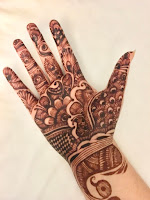The Organic Body Art
 With each of our visits to India, we bring a little piece of the culture back - favorite sweets and savory delights, an ethnic outfit or two, a saree in a classical weave, a stylish piece of jewelry, terracotta toys or bell metal figurines, tribal art and paintings, hard to find CDs or records. Indians living in the US, more traditional in some ways than Indians in India, holding on to the India from decades ago, can find almost anything Indian they need, right here in the US. There are enough businesses and stores catering to every Indian need. Moreover, these days all airlines have weight and size restrictions on luggage, so traveling light has become more of a requirement. But nostalgia sweeps in while walking your favorite streets, pulling you towards your favorite shop, towards that one thing you can’t resist. Before you know it that special thing ends up in your luggage back to the US.
With each of our visits to India, we bring a little piece of the culture back - favorite sweets and savory delights, an ethnic outfit or two, a saree in a classical weave, a stylish piece of jewelry, terracotta toys or bell metal figurines, tribal art and paintings, hard to find CDs or records. Indians living in the US, more traditional in some ways than Indians in India, holding on to the India from decades ago, can find almost anything Indian they need, right here in the US. There are enough businesses and stores catering to every Indian need. Moreover, these days all airlines have weight and size restrictions on luggage, so traveling light has become more of a requirement. But nostalgia sweeps in while walking your favorite streets, pulling you towards your favorite shop, towards that one thing you can’t resist. Before you know it that special thing ends up in your luggage back to the US. 
A few years ago, wandering the markets in Lucknow, my daughter spotted the ideal Indian keepsake. It wouldn’t last for too long, but would leave a lasting memory. She spotted henna artists! In their little make-shift nooks near bigger storefronts, these skilled artists were putting mehndi (henna) on customers’ hands with unbelievable expertise. We had seen some amazing henna art in the US. But these unassuming folks, setting up shops off side-walks, worked with speed and perfection, creating masterpieces on every hand (or feet, if one wanted). Factoring in the dollar-rupee conversion, they charged almost nothing. This was our best shopping and the artists were so happy with the tip, they gave us some henna cones and tips of their own for getting a richer and lasting henna color.
Though I had never been a huge fan of henna, growing up I had seen it being used all around me. I had seen a mixture of henna in a decoction of tea, with eggs, curd, lemon and essential oils, soaked overnight in a cast iron pot, being applied as a natural hair dye. Henna paste was applied to feet and palms during intense heat waves, or to cool down when someone got a heat-stroke. Mehndi also has a very special meaning at Indian weddings, with a ceremony where the bride and sometimes, the groom get exotic designs on hands and all the way up their arms, and on their feet. Mehndi leaves are supposed to have a nerve calming effect, and the long process of someone applying the designs, is meant to ease the bride and groom out of their wedding stress. The designs sometimes hide puzzles, or names, which can be ice-breakers for the couple, besides bringing a romantic spin. The richness of the bridal mehndi color is also connected to a lore about love in the marriage.

Back in the US after our special Lucknow visit, the mehndi design on my daughter’s hands lasted for a week. She shared it with her school friends, many of whom thought it was very cool. Some people thought of it as a temporary tattoo; and it's all organic, natural ingredients had a special appeal. Since then henna art has become a special part of our lives, with us trying to incorporate it into holidays at home, at the Body Art booth at international nights at school, ladies night out, or at fundraiser events. Over the years, it has been very interesting to see the traditional art of mehndi/henna move to newer level of popularity, with people adorning the exotic designs made with this natural dye with an orange hue as body art - on shoulders, necks, backs, ankles, mid-riffs. Of all the ways I had seen it being used before, I thought its coolest use, while being safe, was as an organic, temporary tattoo, in the form of fascinating body art. It was gratifying to see the little piece of culture my daughter spotted on the streets of Lucknow, and brought in the palms of her hand, make its way in the hearts of Americans.
https://www.livesimplynatural.com/natural-henna-tattoo-paste-recipe/
https://www.thetrendspotter.net/henna-tattoos-designs/
https://www.thetrendspotter.net/henna-tattoos-designs/









My dear Gauri.....I love reading your posts on this blog...even though, I am not always able to respond to them.
ReplyDeleteLet me begin by saying, that the very name "Sweet Spot" is so befitting not only the topics you choose, but also to your very persona....sweet and positive... at any given point of time!
It is so true, that those who are away from their countries of birth, the "Pravisis" as we call them, are always more attached to their roots, than those living back home. It is a subconscious way of retaining and nurturing their culture and identity in a different environment.
Thereby, in doing so, every ethnicity here, enriches the American Mosaic.
I loved the information about the different medical and cosmetic contributions and uses of henna. ...thank you.
There is also a very profound and philosophical message that Henna lends to us, in regards to life and its challenges.....
Surḳh-rū hotā hai insāañ...............Thokareñ khāne ke baad
Rañg laatī hai hinā.................patthar pe pis jaane ke baad.
(It is only after going through the grind of life, do we come out shining and more experienced...just the way Henna, releases its colour, once it is ground into a paste)
Thank you and please continue giving us the pleasure of reading your thoughts!